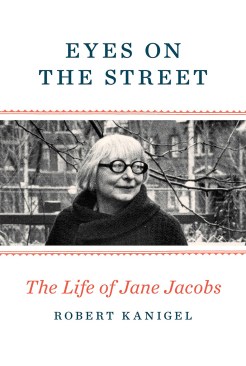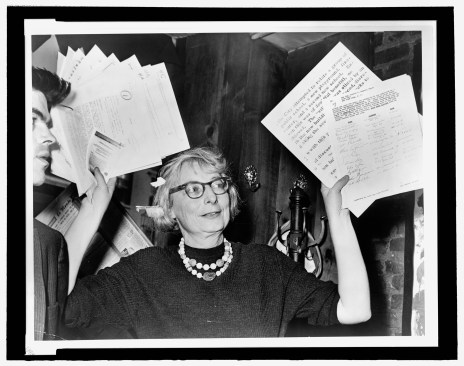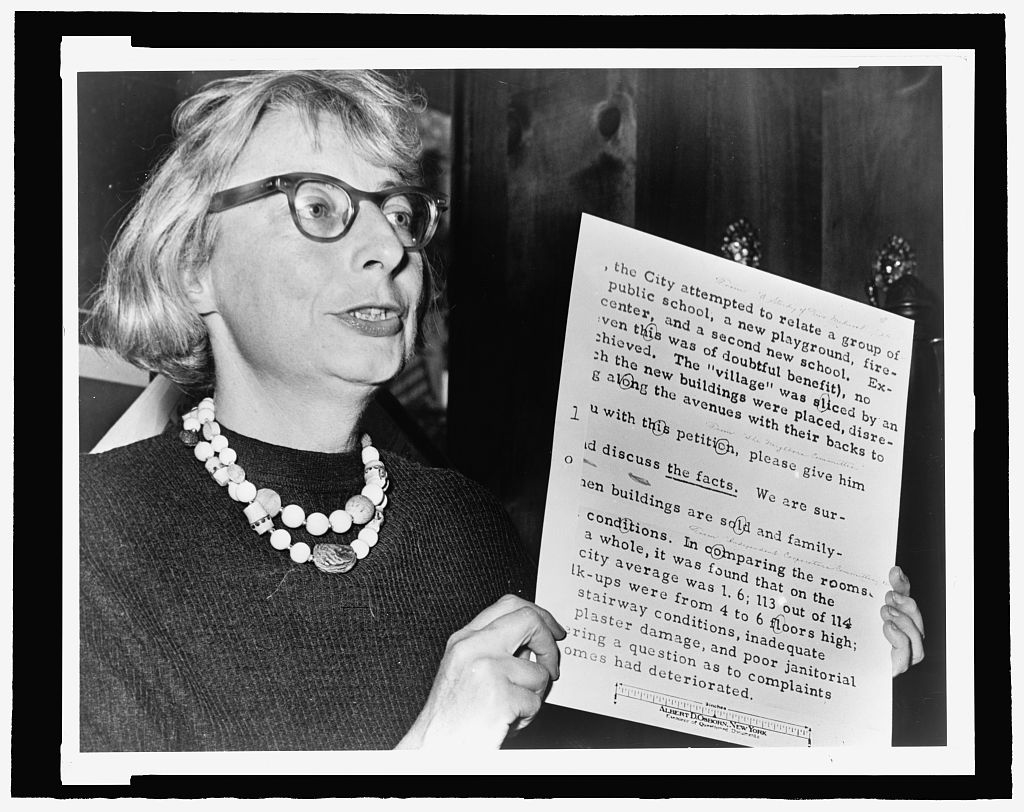In third grade, a tall, curious girl named Jane Butzner was expelled from school. A dentist had come to the school, George Washington in Dunmore, Penn., to talk to students about oral hygiene, and, at the end of his speech, he asked them to promise to brush their teeth, morning and night. Jane’s father, a doctor, had told her that a promise was a serious matter, not to be made lightly. So how could she and her classmates promise to brush their teeth twice a day for the rest of their lives?
The request put Jane in moral jeopardy. She would not raise her hand, and she made sure that the other students did not follow blindly. “Don’t do it,” she whispered. “Don’t do it.” Some of the children who had raised their hands put them down, sowing confusion. When Jane’s teacher found out what she had done, they argued, and Jane refused to back down. She knew she was right. “At her wits’ end, she expelled me,” Jane told an interviewer in 1992. “It came to me good and strong and fast that I was an outlaw.”
In 1952, Jane Jacobs (née Butzner), then a reporter for the American propaganda magazine Amerika, was investigated by the F.B.I. on behalf of the State Department’s Loyalty Review Board. She was suspected of “a degree of immortality and disloyalty” to her country, probably because of her membership in the United Public Workers of America and the American Labor Party, both of which had (some) Communist leadership. Her response to Conrad E. Snow, the chairman of the board, ran to 8,000 words. “It still shocks me, although we all should be used to it by this time, to realize that Americans can be officially questioned on their union membership, political beliefs, reading matter and the like,” she wrote. “First of all, I was brought up to believe that there is no virtue in conforming meekly to the dominant opinion of the moment. I was encouraged to believe that simple conformity results in the stagnation for a society, and that American progress has been largely owing to the opportunity for experimentation, the leeway given initiative, and to a gusto and a freedom for chewing over odd ideas.” At 36, as at eight, she refused to just go along.

In 1958, Jane Jacobs wrote her first article for Fortune, the flagship of the Time-Life media empire. The article had a simple premise put forth in its title: “Downtown is for People.” “All over the country civic leaders and planners are preparing a series of redevelopment projects that will set the character of the center of our cities for generations to come,” she wrote. “What will the projects look like? They will be spacious, parklike and uncrowded. They will feature long green vistas. They will be stable and symmetrical and orderly.” They would be like Lincoln Center, then in the planning stage—a cultural complex of buildings, all faced in the same material, which would replace existing brownstones and tenements that housed more than 16,000 people. “The logic of the projects is the logic of egocentric children, playing with pretty blocks and shouting ‘See what I made!’…” Later in the article, Jacobs implored her readers: “You’ve got to get out and walk.” That is what she had done, as an 18-year-old, in her first Depression-era years in New York, as she applied for secretarial and research jobs. After she’d taken her typing test, or proven she knew shorthand, Jacobs would take the subway to a new stop and get out and walk. “Every place I came out I was amazed,” she wrote.
As Jacobs’s broadside was being readied for publication, the publisher of Fortune, C. D. Jackson, asked who on earth was the “crazy dame” who aimed to give “aid and comfort to critics of Lincoln Center?” A sit-down was arranged with Jackson and the other Fortune editors, including Jacobs’s new champion, the editor William H. Whyte. “When it was over,” Robert Kanigel writes in the first comprehensive biography of Jacobs, “Eyes on the Street” (Knopf, 2016), “Jane asked him why he hadn’t stuck up for her. ‘No need,’ replied Whyte. ‘The poor man’—meaning Jackson—‘thought he’d hit a buzz saw.’ ”
Following Jacobs from birth to buzz saw, as Kanigel does, makes her apotheosis as one of the 20th century’s foremost urban thinkers read as almost inevitable, and I delighted in the details of her life even as I groaned at the author’s lack of architectural understanding (a blueprint is not a sales tool!). “Downtown is for People,” appearing in April 1958, at 6,000 words and with detailed illustrations, was a sensation. After her dismissal of architects as petulant toddlers, Jacobs proceeded to take her own advice. She looked at downtowns in cities such as New York, San Francisco, Philadelphia, and Pittsburgh not as they might be, but as they were: intricate, carnivalesque, quirky, and busy all day long. “People make it, and it is to them, not buildings, that we must fit our plans.”
After her triumph in Fortune, Jacobs proposed a four-part series on city streets to her editors at Architectural Forum, then the country’s leading magazine for the very architects that she side-eyed. As with “Downtown is for People,” she wanted to flip things around. In her mind, it wasn’t just the buildings that make cities, but the streets. Writing for an architecture magazine, her focus had been on clients, designers, and structures, but as a user of cities, she came to realize that the spaces in between were equally (if not more) important. The new acropolises built for culture, housing, and business seemed to push people to the edges. She wanted to write about the size of streets, their design, how elements like stoops contribute to social life, and the way all-day activity allows neighborhoods to police themselves. In other words, “eyes on the street,” a phrase repeated as a mantra by planners such as New York’s Amanda Burden. Three years later, Jacobs would have all the room she needed to explain her theories in her 1961 bestseller, “The Death and Life of Great American Cities,” which opens with Jacobs’s famous description of her own downtown block and its “sidewalk ballet.” Her offbeat ideas finally had room to roam.

Library of Congress
Jacobs, in her role as chairperson of the Commission to Save the West Village, at a 1961 press conference
Yet, as “Eyes on the Street” helps demonstrate, Jacobs’s book was no bolt from the blue. “Death and Life” was the work of a woman who may have been a born critic, but she also put in the work. She thought the public was the client, she spoke from the heart, she spoke as a woman in rooms full of men, but she was no amateur, no housewife, not just a mother, in the phrase of her antagonist, the city planner Robert Moses, whose top-down designs she fought on multiple fronts.
On what would have been Jane Jacobs’s 100th birthday, May 4, 2016, she was honored with a Google Doodle that showed her beloved bob hairstyle, the bicycle by which she commuted from the West Village to the Time-Life Building, her owlish glasses, and the Washington Square Arch (representing the park that she had saved). In the accompanying text by Google, Jacobs is referred to as a “self-taught journalist and community organizer,” positioning her, as Moses did, as an upstart. A caption atop Adam Gopnik’s recent review of Kanigel’s biography in The New Yorker refers to her as an “ordinary mom.” As for Kanigel, he was taken to task by Alissa Walker in a Curbed article for his dismissive jabs at Jacobs’s appearance: “never beautiful,” “a pudding-faced old lady,” “fat and dumpy.”
Indeed, throughout her career, Jacobs was undermined and underestimated as a woman without credentials. In 1962, a year after she published “Death and Life,” she was patronized in The New Yorker by the eminent critic Lewis Mumford, in a piece titled “Mother Jacobs’ Home Remedies.” Mumford first credits Jacobs as a new kind of “expert,” one using her eyes and her heart, before characterizing the book as patchy, local, prejudiced and misinformed. Expert status, revoked. “Mrs. Jacobs is at her best in dealing with small, intimate urban areas,” Mumford writes. He takes personal offense at her attacks on redoubtable planning figures like Ebenezer Howard (inventor of the Garden City) and Clarence Stein and Henry Wright (designers of his home, Sunnyside Gardens in Queens). What Mumford can’t stand is her preference for a city that grows organically, the product of many minds and hands. “That beauty, order, spaciousness, clarity of purpose may be worth having for their direct effect on the human spirit … seems not to occur to her.”
Yet, once you read deeply into Jacob’s life and writings, you can’t help but reject this belittling view of her as an upstart. Yes, she had kids. No, she never earned a college degree. But Jacobs lived through New York’s postwar building boom as a reporter first for a trade journal, then as a writer chronicling the fabric of everyday American life (including slums) for Amerika, and finally as a contributor to Architectural Forum. It is hard to think how she might have been better prepared to take on the planning establishment. She even had a number of influential supporters from within the establishment itself: The Architectural Forum editor Douglas Haskell, the Fortune editor Whyte (author of one of the other most influential city planning books of the century, “The Social Life of Small Urban Spaces”), the Rockefeller Foundation associate director Chadbourne Gilpatric, and the Random House editor Jason Epstein would all recognize and support her gifts. What Kanigel shows is the tremendous support that she also received at home, first from her parents, and then from her husband (an architect) and children.
When The Wall Street Journal reviewed “Death and Life,” it put the sentiment more strongly: “In another age, the author’s enormous intellectual temerity would have ensured her destruction as a witch.”
In Kanigel’s often melodramatic retelling (trying to make planning cinematic is an uphill task), Jacobs’s epiphany comes in Philadelphia, in the company of that city’s redoubtable planning commission director Edmund Bacon. He took her to two streets in a black neighborhood, the first run-down and crowded with recent arrivals in the Great Migration, the second redeveloped with new high-rises. You can imagine his hand gestures, smoothing over and rubbing out, replacing the past with the new and the orderly. By this point, Jacobs has seen enough slum clearance projects to look beyond the “lovely vista.” “There was no human being on the street except for a little boy kicking a tire,” she recalled in a 2004 speech. “ ‘Where are the people?’ Bacon didn’t answer. He only said, ‘They don’t appreciate these things.’ ” Later, she would intellectualize her observation, writing, “There is a quality even meaner than outright ugliness or disorder, and this meaner quality is the dishonest mask of pretended order, achieved by ignoring or suppressing the real order that is struggling to exist and be served.” A simple, challenging question was her first step toward the insights that would motivate “Death and Life,” and it’s fitting that the sight of a little boy would lead her there.
Kanigel implies that daily tasks of family life slowed her down, and the biography is filled with quotes from letters that testify to the difficulty of her writing process: how she goes wildly over her prescribed word counts or misses initial deadlines. Yet I believe her private life also gave her a different, essential perspective. In a 1978 interview, Jacobs specifically credited the maternal insight of two of her colleagues on the Washington Square picket line: “[I]t was Edith Lyons and Shirley Hayes—who sat in the park with their little kids—they wondered why they should be stuck with either of these [a road through the park, or the widening of the road around it], and why you had to have additional roads for traffic around Washington Square Park at all. And they were considered crazy women who just didn’t understand the facts of life.” When The Wall Street Journal reviewed “Death and Life,” it put the sentiment more strongly: “In another age, the author’s enormous intellectual temerity would have ensured her destruction as a witch.”
Kanigel plays at being confounded by Jacobs’s influence and concludes: “They came under her spell, I think, almost solely through her words.” But it is also rare that a critic goes to the picket lines and brings along wit and verve. Three times Jacobs probably felt that she had no choice. Washington Square Park was her playground; Moses’s proposed Lower Manhattan Expressway threatened her home on Hudson Street; and, after she moved to Toronto, her new home was imperiled by another new expressway, the Spadina. She didn’t like leaving her typewriter and yet she had a flair for the dramatic. She threw her intellect into disrupting the power structure, staging photo ops with children, writing funny signs, even downing fences. “This morning at 6:30 AM,” she wrote to Epstein, her editor at Random House, “I helped knock down a lot of fences around some houses that were to be wrecked for a horrid apartment tower, thus staving off the wreckers, because they aren’t allowed to wreck without a fence up. Very satisfying.”
The problem for a biographer is that Jacobs and her offspring have all the best lines. Kanigel sometimes feels like a setup man, and at other times like an encumbrance. Many an architecture profile goes unwritten because the subject is insufficiently charismatic; Jacobs has charisma (and, apparently, letters) to spare. Even a shopping trip with her sons at Macy’s turns into a scene from an insurrectionist sit-com. “Is the long underwear for hunting or for fishing?,” a clerk asks. “It’s for picketing,” replies Jane. A few years later, when the boys are older, Jane is arrested at a public hearing about the Lower Manhattan Expressway at Seward Park High School, and after “the prosecutor made such a case of what a monster I was,” she arrived home depressed. When her oldest son, Ned, came home from school, she told him what had happened. He listened, then said, “You know, for a woman of fifty-three, you lead a very exciting life.” “All of a sudden,” she recalls, “I felt about a thousand percent better.”
At its best, “Eyes on the Street” allows us to see Jacobs as a prototypical modern woman, not a cardboard saint, biking to work at the Time & Life Building, using her (willing) children as props in protests, fighting for time to write, talking everything over with her supportive architect husband.
Where do critics come from? They come from families like the Butzners. On another day, young Jane was sent to the principal’s office (again) for doing something foolish. The principal called her father, who responded: “I’m a busy man. You’re a busy educator. I’ll take care of my problems. You take care of yours.” With “Death and Life,” by fighting expressways, in asking, “Where are the people?,” Jane Jacobs was trying to take care of her problems, and ours.
